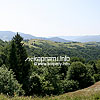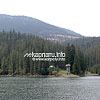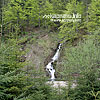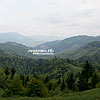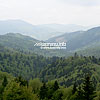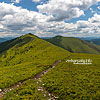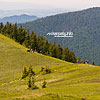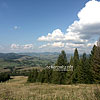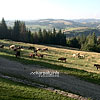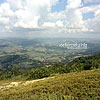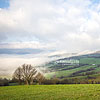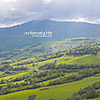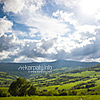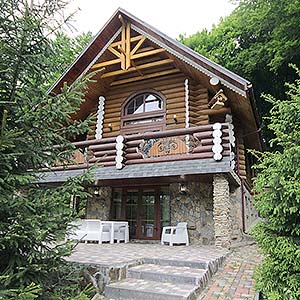Volovets district
It is located in the northern part of Zakarpattia oblast within the Vododilnyi and Polonynskyi mountain ranges. The highest peak is Mount Velykyi Verkh (1598 metres above sea level) located on the border with Mizhgirya district. The mountain ranges from Pashkivtsi up to Vysokyi Kamin near Pidpolozzya are considered to be the floristic reserve 'Pikui' where a lot of valuable rare plants, especially medicinal ones, are protected.
All the rivers of Volovets district are the tributaries of the Latorytsia river (the Danube basin) which source is on the slopes of the Verkhovynskyi mountain range, under Veretskyi Pass. It gives its name to the village of Latirka located on the both banks of its stream bed that is getting affluent with the flow. A lot of small rivers fall into the Latorytsia, among them: the Bashta and the Slavka that flow through Verkhni Vorota as well as the Kachurka (Verbyazh, Zavadka), the Vicha (Huklyvy, Volovets), the Zhdenivka (Zhdeniyevo) and others which sources are located high in the mountains. All of them have rapid flows, steep banks and narrow valleys.
The district is rich in mixed coniferous forests where spruce, fir tree, beech, ash tree and sycamore grow. In summer and autumn, you can find a lot of mushrooms and berries hiding among the trees.
Volovets district is a part of the ethnographic region of Boykivshchyna, one of three famous historical-ethnographic groups of the Ukrainian Carpathians — Hutsuls, Boykos and Lemkos that have a crucial difference in their everyday life, customs, rituals and material culture.
The district centre is the urban-type settlement of Volovets.
Volovets district is the motherland of Ukrainian poetess with a difficult fate Sofia Malylio that was born in the village of Verkhni Vorota.
In the district, tourist infrastructure is developing step by step. A lot of new hotels are opening in the resort Zhdeniyevo where there is a ski lift. For those who stop in Volovets, the lifts in the villages of neighbouring Mizhhirskyi district — Podobovets (about 10 km) and Pylypets (about 15 km) — will be available. Paragliding, orienteering and other competitions are held in the district. Here, a lot of hiking routes are laid, the most popular of them are from Volovets to The Borzhava Mountain Valley and from Pashkivtsi and Zhdeniyevo to the Vododilnyi mountain range.
There are 7 mineral springs in Volovets district. The most famous of them is located in Zanka. Baths held by the forestry had been working here for a long time.
The Árpád Line
Observing the defeats of their allies Germans on the Eastern Front since summer 1943, Hungary had started creating the defense system, so-called 'the Árpád Line', in mountainous areas of the Carpathians. It stretched for 350 km along the tops of mountain ranges, and its width was about 120 km in some places. The frontier was additionally strengthened by 99 strongholds, 750 pillboxes, 343 DZOTs (tree-earthen defensive points), 439 open firing points and 400 km of anti-personnel and anti-tank trenches. Barbed wire (12 km in length) with a voltage of 3000 V was set at the entrances to the village of Yasinia and Yablunytskyi Pass. However, the units of Soviet army managed to overcome this defense system but more than 10 thousand of their soldiers were killed in the battle. Bunker of Arpad Line in Verhnya Hrabivnytsya village and pillbox in Pidpolozzya village belong to the most famous remains of the Árpád Line.Wooden churches
- Church of Presentation of the Blessed Virgin Mary (1804), the village of Abranka
- Church of Transfiguration (1878) with a belfry (the beginning of XX cent.), the village of Verbyazh
- Church of the Holy Spirit with a belfry (the beginning of XVIII cent.), Huklyvy
- Church of St. Nicholas with a belfry (the beginning of XX cent.), the village of Zadilske
- Church of the Holy Spirit with a belfry (the end of XVIII cent.), the village of Kotelnytsia
- St. Mary's Assumption Church with a belfry (1898), the village of Tyshiv
- Church of the Ascension of Jesus with a belfry (XIX cent.), the village of Yalove
- Chapel, built in honor of the abolition of serfdom (1848, 1928); the village of Verkhni Vorota
Nature reserves
- Floristic reserve 'Pikui'
It is located on the border with Lviv region. A lot of valuable rare plants as well as beech woodland with remains of beech krumholtz on the slopes of Mount Pikui are protected here. - Forest reserve 'Rosishnyi' (western slopes of Mount Stiy)
Elite fir plantations are preserved here, as well as the range of rare plants — hart's-tongue fern, ostrich fern and martagon lily. There is also a beech virgin forest here. - Botanical reserve 'Buzok' (Zhdenievske forestry)
A rare endemic species of Hungarian lilac recorded in the Red Data Book of Ukraine is protected here. It can be found in the thicket of grey alder mixed with common ash, rowan and sycamore, and it forms the understory together with European spindle, honeysuckle, alder buckthorn and goat willow. Vegetation cover consists of marsh-marigold, meadowsweet, sedges, white hellebore, bittersweet nightshade and others. - Zoological reserve 'Potik Osa'
Brown trout, fire salamander, Carpathian newt and alpine shrew are protected here. - Nature reserve 'Holytsia', near the village of Nyzhni Vorota
Some kinds of broom (spartium), crocus and other rare plants recoreded in the Red Data Book of Ukraine are protected here. - Botanical natural monument 'Hora Vysokyi Kamin'
It is famous for the highest range of growth of the sessile oak and black pine in the Carpathians, and also for relict groupings with dominating of the large-leaved and small-leaved linden that are preserved on the steep slopes and rocky ridge at an altitude of 840 metres above sea level. On the top of the mountain, there is one of two relict places of growing of Scots pine in Transcarpathia. On the stone placers, you can encounter bushes of mountain currant and gooseberry. - Botanical natural monument 'Tys Yahidnyi' (Pidpolozianske forestry)
It is a place of growing of English yew that is recorded in the Red Data Book of Ukraine. The trees are about 300 years old.
| Service | Address | Phone number |
|---|---|---|
| Volovets District Council | 30 Nezalezhnosti Street | +38 (03136) 2-22-66 |
| Volovets Settlement Сouncil | 7 Pushkina Street | +38 (03136) 2-25-33 |
| Telephone number information service | +38 (031) 991-09-11 | |
| Central district hospital | 23 Karpatska Street | +38 (03136) 2-43-00 |
| Round-the-clock pharmacy | 23 Karpatska Street (in the district hospital) | |
| Pharmacies | 46 Karpatska Street 50 Karpatska Street | |
| Post office | 6 O. Pushkina Street | +38 (03136) 2-22-85 |
| Mountain search and rescue service | 110 Tsentralna Street, Nyzhni Vorota village | +38 (050) 273-76-45 |

 Ukraine
Ukraine Poland
Poland Slovakia
Slovakia
 Українською
Українською